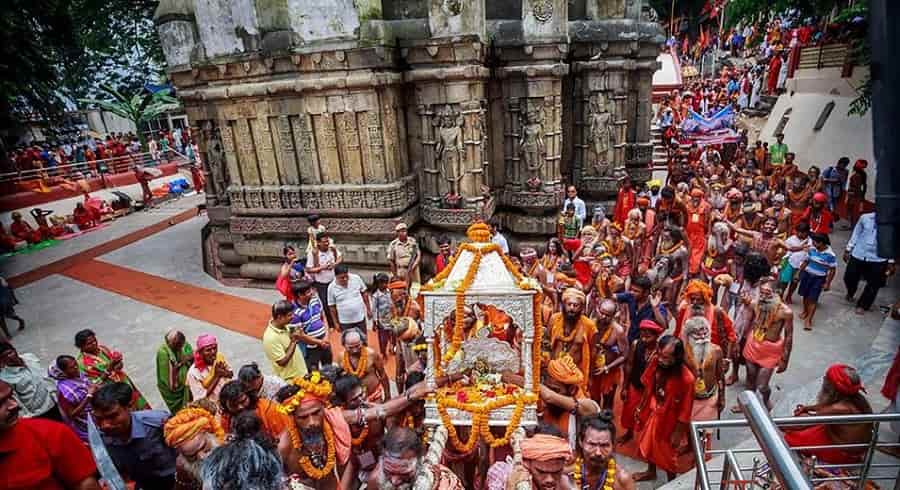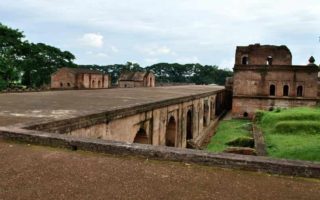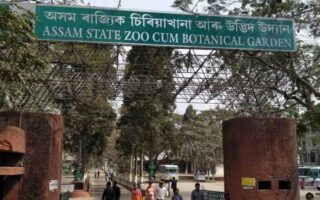Ambubachi Mela is one of the most significant and unique religious festivals celebrated at the Kamakhya Temple in Guwahati, Assam, India. It is an important festival for Tantric and Shakta practitioners, drawing devotees from all corners of India and abroad. The festival is celebrated annually during the rainy season, typically in June, and spans for about 4 to 7 days.
- Situated: Kamakhya Temple, Guwahati, Assam, India
- Devoted To: Goddess Kamakhya
- Rituals: Tantric rituals, mantras, and puja.
- Legend: Linked to Goddess Parvati’s body parts, which are believed to have fallen at this site.
- Attractions: Devotees, Pandas, Sadhus, and local crafts on display.
- Time of the Festival: Rainy season
- Dates – June 22 to June 26, 2025
- Duration: (4-7days)

Rituals and Legends
Ambubachi Mela, or Fair, is held annually during the rainy season at the Kamakhya Temple in Guwahati. Various beliefs and legends are associated with this fair. It is a major festival celebrated in Assam and is of immense importance, especially for the locals. This fair attracts many devotees from across India as well as from around the world. The fair is intimately related to the rituals of Tantric knowledge that are carried out during the Ambubachi Mela.
Major Attractions
This fair is held annually during the rainy season at the Kamakhya Temple located in Guwahati. The fair is related to the catamenial cycle of Goddess Kamakhya. During this time, the Kamakhya Temple remains closed for 3 days, and all the devotees gather in the temple premises and anxiously wait for the 4th day, when they are allowed to take darshan (viewing) of the Devi.
The gathering of Pandas and Sadhus from across the country, along with local crafts and art items kept for trade on the roadside, make the fair a vibrant and interesting place. Devotees offer puja, and pundits chant mantras on behalf of the disciples, making it a spiritually enriching affair.
Traditions and Rituals
A very important feature of the Ambubachi Mela is the adoration linked to Tantric rituals. Generally, this time is set for heavy rainfall for an entire week, which is known as ‘xaat’. It is said that the rains cleanse the earth, preparing it for the harvest. According to old beliefs, it is said that one should only consume summer fruits after the Ambubachi Fair and this one week’s rainfall.
Legends
The great legend behind this fair is related to Goddess Parvati and Lord Shiva. According to mythology, Goddess Parvati had decided to marry Lord Shiva since her childhood. She underwent rigorous fasting and meditation to please Lord Shiva, who at last agreed and accepted Goddess Parvati as his better half. However, Parvati’s father and mother were not pleased with this match. Once, King Daksha, Parvati’s father, organized a Yagna (sacrificial fire ceremony) but did not invite his daughter and son-in-law. Goddess Parvati got angry at this gesture and went to her parents to ask for an explanation. King Daksha insulted Parvati by calling Lord Shiva poor and wild. Unable to tolerate the insult, Parvati jumped into the Yagna fire and ended her life.
When the angry Shiva came to know of this, he was devastated and furious. He rushed to his father-in-law’s house, and upon seeing the dead body of his beloved wife, he began performing the ‘Tandav’ dance of destruction. He continued dancing for many days, and as a result, the earth was on the verge of destruction.
The Gods and Goddesses became concerned and requested Lord Vishnu to remove the body of Goddess Parvati from Lord Shiva’s shoulder, as it was believed that this would calm him and stop the destructive dance. On hearing their plea, Lord Vishnu used his chakra (discus) to cut the body parts of Goddess Parvati. It is believed that the body parts of Goddess Parvati fell at various places across the country, which are now known as Shakti Peeths (centers of power). The private part of Goddess Parvati is believed to have fallen on the top of Nilachal Hill in Guwahati, where the Kamakhya Temple stands today. For three consecutive days before the Mela, the temple remains closed to devotees, as it is said that during this time, Goddess Parvati undergoes her menstrual cycle and needs solitude and rest.
Another legend suggests that the demon Narakasura fell in love with Goddess Kamakhya and wanted to marry her. However, it is said that a Goddess can never marry an Asura (demon). Goddess Kamakhya devised a plan to escape his advances. She set the condition that she would only marry him if he constructed a temple for her in one night. Narakasura agreed to this and worked through the night to complete the temple. Just before dawn, a rooster crowed, signaling the arrival of morning. Narakasura became furious and killed the rooster. However, as per the earlier agreement, it was already too late, and thus Goddess Kamakhya was saved. It is believed that the current temple is the one that Narakasura built for Goddess Kamakhya.


